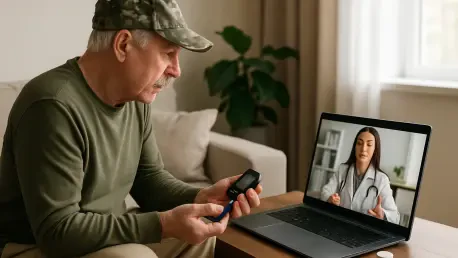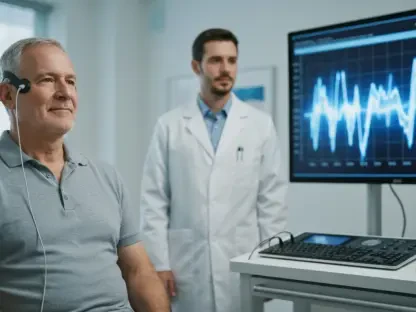In an age where digital innovation is reshaping every facet of life, healthcare stands at the forefront of this transformation, particularly for managing chronic conditions like diabetes among older veterans. A pivotal study published in the Journal of General Internal Medicine this year reveals striking insights into how telehealth, a method of providing medical care remotely through technology, compares to traditional in-person consultations for this specific population. Older veterans, often grappling with mobility limitations or living in remote rural areas, face significant hurdles in accessing timely medical services, making this research not only timely but essential. The findings suggest that telehealth could be a game-changer, offering a lifeline to those who struggle with conventional healthcare access. By delving into patient experiences, clinical outcomes, and broader implications, this analysis highlights the potential of virtual care to redefine chronic disease management for a vulnerable group, paving the way for a more inclusive healthcare landscape.
Enhancing Access and Patient Satisfaction
Telehealth has emerged as a powerful tool in bridging the gap for veterans who face daunting barriers to healthcare access, especially those in isolated regions. The research underscores that many older veterans with diabetes struggle with long distances to medical facilities, compounded by transportation challenges or physical limitations. Through virtual platforms, these individuals can connect with healthcare providers without leaving their homes, a convenience that has proven transformative. This approach not only saves time and reduces stress but also ensures that critical care is not delayed due to logistical issues. By eliminating the need for travel, telehealth addresses a fundamental inequity in healthcare delivery, ensuring that geography no longer dictates the quality or timeliness of medical attention for these patients.
Beyond accessibility, the satisfaction levels reported by veterans using telehealth are a revelation, often matching or even surpassing those associated with face-to-face visits. The ability to engage with doctors from the comfort of familiar surroundings fosters a sense of ease and security, which is particularly meaningful for a demographic that may find travel burdensome. This high satisfaction reflects how telehealth meets both practical and emotional needs, debunking the notion that remote care feels impersonal. Veterans have noted that virtual consultations allow for meaningful interactions with providers, reinforcing trust and engagement in their treatment plans. As a result, this mode of care is not just a temporary solution but a viable alternative that resonates deeply with those who have historically faced obstacles in accessing medical support.
Clinical Outcomes and Continuity of Care
When it comes to the effectiveness of managing diabetes, telehealth stands shoulder to shoulder with traditional in-person care, according to the study’s detailed analysis. Key health indicators such as blood sugar levels, adherence to medication schedules, and rates of hospital admissions showed no significant disparity between the two methods. In fact, for some veterans, the consistent follow-ups enabled by remote monitoring led to better control over their condition, challenging long-held assumptions that physical presence is always necessary for optimal outcomes. This parity suggests that virtual care can deliver the same level of clinical rigor as conventional methods, providing a robust option for chronic disease management among aging populations with complex health needs.
Equally important is the role telehealth plays in maintaining continuity of care, a critical factor in handling a condition like diabetes that requires ongoing attention. The study highlights how regular virtual check-ins allow veterans to stay closely connected with their healthcare providers, facilitating quick responses to emerging symptoms or concerns. This seamless communication helps patients stick to their treatment regimens more effectively, reducing the risk of complications that might arise from gaps in care. Unlike sporadic in-person visits that may be disrupted by external factors, telehealth offers a steady line of support, empowering veterans to manage their health with greater confidence. This consistent engagement marks a significant advantage, positioning remote care as a cornerstone of sustained medical oversight.
Empowerment Through Education and Tech Challenges
Telehealth extends beyond mere consultations, serving as a vital conduit for patient education among veterans managing diabetes. The research indicates that access to virtual sessions and digital resources has enabled many to gain a deeper understanding of their condition, from recognizing symptoms to adopting healthier lifestyle choices. This knowledge equips them to take an active role in their health, fostering a sense of empowerment that is crucial for long-term management of chronic illnesses. By demystifying complex medical advice through accessible formats, telehealth ensures that veterans are not just passive recipients of care but informed participants, capable of making decisions that enhance their well-being and improve their quality of life over time.
However, the promise of telehealth is tempered by significant technological barriers that cannot be overlooked, especially for an older demographic. Issues such as unreliable internet connections, lack of access to suitable devices, or unfamiliarity with digital tools pose real challenges, as noted in the study. These obstacles can prevent some veterans from fully benefiting from virtual care, highlighting a digital divide that risks leaving certain groups behind. Addressing these hurdles requires targeted interventions, such as providing affordable technology or offering training programs tailored to less tech-savvy individuals. Without such measures, the full potential of telehealth remains out of reach for a portion of the veteran population, underscoring the need for inclusive strategies to ensure equitable access.
Systemic Impact and Future Horizons
The rapid adoption of telehealth, accelerated by the constraints of the COVID-19 pandemic, has provided a real-world proving ground for its scalability and resilience. The study points out that when in-person visits became infeasible, virtual care stepped in to maintain essential medical services for veterans with diabetes, demonstrating its capacity to adapt under pressure. This shift not only preserved access during a global crisis but also offered valuable data on how telehealth can function as a permanent component of healthcare systems. For vulnerable populations like older veterans, this adaptability signals a broader potential to integrate remote care into routine practice, ensuring that disruptions—whether due to health crises or personal limitations—do not derail critical medical support.
Looking ahead, the implications of telehealth extend to systemic benefits, including cost-effectiveness and resource allocation within healthcare frameworks. By reducing the need for physical appointments, telehealth has the potential to lower expenses associated with chronic disease management, freeing up resources for other pressing needs. The study suggests that this efficiency could reshape how care is delivered, particularly for aging veterans who require frequent monitoring. As healthcare systems grapple with rising costs and strained infrastructures, embracing telehealth offers a pathway to optimize service delivery without compromising quality. This forward-thinking approach positions remote care as a strategic tool in building a more sustainable and responsive medical ecosystem for the future.
Reflecting on a Digital Shift in Veteran Healthcare
Looking back, the exploration of telehealth’s role in managing diabetes among older veterans revealed a landscape of opportunity tempered by challenges. The evidence showed that virtual care matched in-person consultations in clinical effectiveness and patient satisfaction, while dramatically improving access for those in remote areas. It proved its worth during unprecedented times, maintaining continuity when traditional methods faltered. Yet, technological barriers reminded stakeholders of the work still needed to ensure inclusivity. As a next step, healthcare systems should prioritize investments in infrastructure and training to bridge the digital divide, alongside policies that embed telehealth into standard care protocols. Future efforts must focus on refining these platforms to address diverse veteran needs, ensuring that no one is left behind in this digital evolution. This balanced approach promises to sustain the momentum of telehealth as a transformative force in veteran healthcare.









